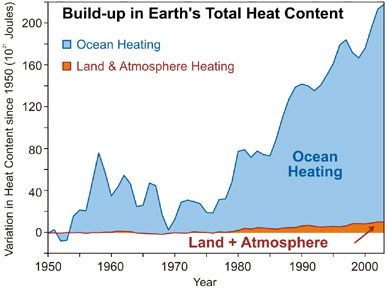Just as worldwide efforts on climate change are beginning to bear fruit, evidence that we waited way too long is also evident.
Scientists at Pacific Northwest Labs predict that climate change has reached the tipping point and we must brace ourselves for accelerating global temperature rise – potentially 0.25°C per decade – a pace not seen for at least 1000 years, reports The Guardian.
"In these climate model simulations, the world is just now starting to enter a new phase, where rates of temperature change are consistently larger than historical values over previous 40-year time spans," lead scientist Steve Smith told The Guardian.
By 2040, costs related to climate change could become a "serious challenge" for businesses, because of property damage from severe weather. Costs could rise by a factor of 10 by then, say economists who conducted the study.
The lull that Republicans love to point to is ending. One of their main climate denial talking points is that temperatures haven’t increased in the past 10-15 years. While that is false – the past decade was the warmest ever, topped by 2014 – temperatures have been rising slowly because the ocean has been absorbing almost all the heat.

But the ocean is saturated now and we will soon be feeling the impact. Scientists are seeing signs that the oceans might be starting to release some of that pent-up thermal energy.
"Pacific trade winds, for instance, which have been unusually strong for the past two decades thanks to a 20- to 30-year cycle called the Interdecadal Pacific Oscillation, have been pumping atmospheric heat down into the western Pacific. The winds are powered by the cycle’s current negative, or cool, phase. But scientists say that when the cycle eventually swings back to its positive, warm phase, which history suggests could occur within a decade, the winds will wind down, the pumping will let up, and buried heat will rise back into the atmosphere," reports Yale360.
"Without the winds’ cooling action, atmospheric temperatures could surge as they did in the 1980s and 1990s, the last time the oscillation was positive. During the next positive phase, "it’s very much likely that warming will be as fast or even faster because greenhouse gases are now more elevated," explains Matthew England, ocean sciences professor at University of New South Wales.
"Greenhouse gases in the atmosphere are at such high concentrations compared to what they were 100 years ago that you don’t need to bring heat back up from the ocean to the surface to get future warming – you just need to slow down the heat uptake by the ocean, and greenhouse gases will do the rest," he adds.
"The ocean’s doing us a favor by grabbing about 90% of our heat, but it’s not going to do it forever," warns John Abraham, a thermal sciences professor at University of St. Thomas in Minnesota.
When carbon dioxide was at these levels previously in history, polar ice melted and flooded the oceans, raising sea level up to 130 feet higher than today’s levels.
Read our article, In the US, the Climate Is A’Changing, Data Shows.
Read the full article, How Long Can Oceans Continue To Absorb Earth’s Excess Heat?:
